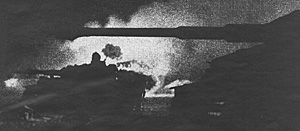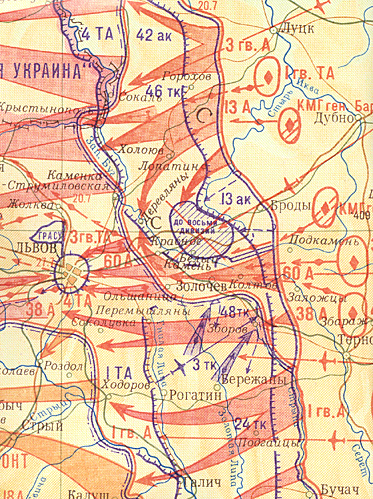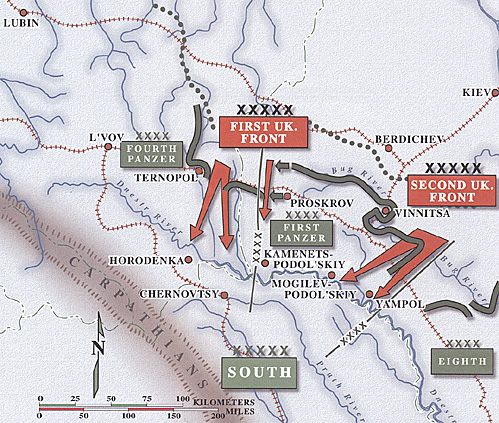 For most of the standard histories of WWII, the most neglected battle must be the Kesselschlacht of Hube's 1st Panzer Army. For example, Earl Ziemke's Stalingrad to Berlin devotes a mere 2-3 pages; John Erickson's The Road to Berlin has 2 pages; Manstein's Lost Victories concerns itself with the author's arguments with Hitler and deals with the Kesselschlacht tangentially; and so on.
For most of the standard histories of WWII, the most neglected battle must be the Kesselschlacht of Hube's 1st Panzer Army. For example, Earl Ziemke's Stalingrad to Berlin devotes a mere 2-3 pages; John Erickson's The Road to Berlin has 2 pages; Manstein's Lost Victories concerns itself with the author's arguments with Hitler and deals with the Kesselschlacht tangentially; and so on.
This neglect may be due to the greater fame or infamy of the Korsun Pocket engagement, which took place immediately before. While the Korsun Pocket was tragic fo rthe German side, the consequences of the destruction of the 1st Panzer Army would have been far greater, and fa more immediately disastrous.
This army was actually the equivalent of an army group with over 20 divisions. Had the Soviets closed the snare permanently, the loss of 1st Panzer Army would have dealt a near death blow to Hitler.
And it almost happened.
Background
 As a result of heavy German losses suffered by the German 8th Army in the Korsun Pocket (Cherkassy) in February 1943, von Manstein, commander of Army Group South (AGS) was forced to shuffle his armies.His forces from north to south consisted of 4th Pz Army, 8th Army, and 1st Pz Army. 1st Pz Army moved from the south to the middle of his line occupied by the now shattered 8th Army. This move did not go unnoticed by the Soviets, who craftily prepared to hit 8th Army again.
As a result of heavy German losses suffered by the German 8th Army in the Korsun Pocket (Cherkassy) in February 1943, von Manstein, commander of Army Group South (AGS) was forced to shuffle his armies.His forces from north to south consisted of 4th Pz Army, 8th Army, and 1st Pz Army. 1st Pz Army moved from the south to the middle of his line occupied by the now shattered 8th Army. This move did not go unnoticed by the Soviets, who craftily prepared to hit 8th Army again.
On March 4th, two large-scale Soviet onslaughts to the north and south of 1st Pz Army rolled over the German lines, striking for Shepetrovka and Uman. To the north, 4th Pz Army was crushed and fell back 85 miles. To the south, 8th Army recoiled back to the Bug River. 1st Pz Army, with no reserves, kept pace with 8th Army's retreat by pulling back to the Dnestr River east of Mogilev-Polosky, but could not begin to cope with the rout of the 4th Pz Army. Before long, a huge gap had formed between the German 4th and 1st Panzer Armies.
The Soviet Supreme HQ (STAVKA) on March 13th confirmed Zhukov's plan to turn the offensive against 4th Pz Army 90 degrees and sweep south over the Dnestre River. The main objective was the city of Chernovtsy. The Soviet 1st Tank Army would move towards Chortkov and 4th Tank Army to the city of Kamenez-Podoisk. Further south, the Soviet 18th Army and 38th Army would move west to link up. All these actions would neatly pocket the German 1st Pz Army. The Soviet 60th Army would keep up ts pressure on the garrison surrounded in Ternopol and further to the north the 13th Army would strike for Brody.
By March 17th, th etenuous German front line linking the two panzer armies was established and lasted about a day. On the 18th, the Soviets blew holes in it and by the 22nd, the Soviet 5th Tank Corps was pouring through between the Zbruch and Sret Rivers, then crossing the Dnestr River on the 24th, well on its way to Chernovtsy.
This was not all, as the Soviets had also moved on Yampol and Mogilev-Podoisky. The state of German readiness is best illustrated by a story concerning the commander of the German 75th Division. He ordered a reconnaissance of the area but his division was unable to do so since it had only one operational vehicle -- a Volkswagen! During this time the main supply base of First Panzer Army was moved from Kamenets to south of the Dnestr River to avoid capture. Soviet forces operating south of the river then promptly captured it.
Upon hearing these developments, Hitler immediately gave explicit orders demanding no withdrawals. Hitler and Manstein would soon be conducting a war of their own on what should and should not be done. On March 23rd, Manstein ordered the commander of First Panzer Army, General der Panzertruppen Hube, to re-establish contact with the Fourth Panzer Army. To accomplish this Hube was given control of an additional corps far to the rear in the Stanislau area -- the Hungarian VII- - and ordered that corps to attack eastwards and secure the bridgeheads at Usteschko and Galich.
 The chance of this happening was, of course, doubtful. Hube
was also given control of "Group Mauss", an agglomeration of divisions
(drifting in the direction of Hube anyway) comprising of the Ist SS
Panzer, 7th Panzer, and 68th Infantry Divisions, plus the 503rd Heavy
Tank Battalion armed with Tiger tanks.
The chance of this happening was, of course, doubtful. Hube
was also given control of "Group Mauss", an agglomeration of divisions
(drifting in the direction of Hube anyway) comprising of the Ist SS
Panzer, 7th Panzer, and 68th Infantry Divisions, plus the 503rd Heavy
Tank Battalion armed with Tiger tanks.
On March 24th, elements of the Soviet Fourth Tank Army seized Skala and began an attack toward Kamenets reaching the Dnestr River northeast of Gorodenka.
By the 25th, it was official: First Panzer Army was encompassed. Hube at this time had enough ammunition and food for two weeks but fuel was already critically low and he issued orders for gas rationing. All vehicles out of fuel were destroyed. Resupply by air was an option but the closest airbase was located 125 miles away at Lvov. The Soviet pressure continued along the east flank with strong attacks, while to the north attacks were moderate, and almost nil from the west.
Kesselschlacht March-April 1944
- Introduction and Background
Terrain and Weather
The Deception
The Battle Begins
Breakout
Aftermath
The Face of Battle
All Daily Situation Maps (monstrously slow: 1.646Mb!)
Back to Table of Contents -- Against the Odds vol. 1 no. 3
Back to Against the Odds List of Issues
Back to MagWeb Magazine List
© Copyright 2002 by LPS.
This article appears in MagWeb.com (Magazine Web) on the Internet World Wide Web.
Other articles from military history and related magazines are available at http://www.magweb.com
* Buy this back issue or subscribe to Against the Odds direct from LPS.
